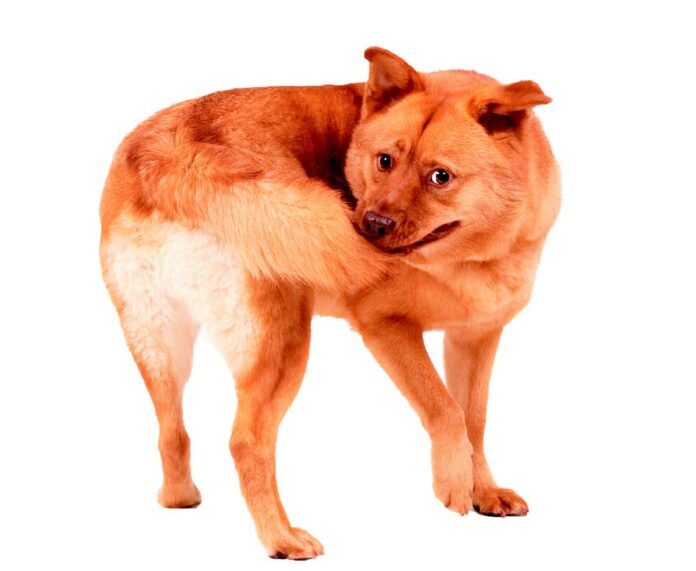For some dogs it’s tail chasing to the point of exhaustion. For others, it’s continuous licking of the lower legs and feet — so much so that the dog strips off part of his skin and develops a pink and knobby heap of granulation tissue called acral lick dermatitis. (The non-stop licking can even end up inflaming bone and surrounding tissue.) For yet other dogs it might be flank or blanket sucking that can lead to chewing off and ingesting bits of material and ending up with a potentially fatal intestinal obstruction.
Technically the condition is called canine compulsive disorder because we can’t know for sure that a dog is obsessing when he engages in repetitive behaviors. But for all intents and purposes, it is obsessive compulsive disorder, or OCD. Even the Animal Health Foundation calls it OCD and says that up to 3 percent of dogs have it. That may not sound like a large number, but it translates to about a million and a half pet dogs in the U.S. Put another way, OCD is often the third most common reason for referral to behavioral clinics, after aggression and phobias.
A genetic component?
It’s not completely clear why a dog would develop OCD, but there appears to be a genetic component. Dobermans are the breed most likely to engage in flank sucking, for instance, while bull terriers are often the ones who chase their own tails.
There also appears to be an emotional stress component that triggers the self-damaging behavior. The thinking among some researchers is that if a dog doesn’t have the right outlets for engaging in behaviors for which he is genetically primed, he might create those outlets in ways that prove harmful. A dog with a high predatory drive who doesn’t get to hunt, for instance, could end up hunting his tail almost every waking moment. We may not always understand which natural behavior the obsessive behavior mimics or stands in for, but if a dog feels anxious enough and has a genetic blueprint for developing OCD in the first place, the unfortunate, almost never-ending repetitions can begin.
Treating the problem
Before you treat OCD-like behavior, it’s important to get a professional evaluation by a veterinarian. That’s because some behaviors that seem like behavioral compulsions could be a sign of problems that require strictly medical treatment rather than psychological solutions. We treated one dog who seemed to have OCD in the form of fly snapping — a constant effort to bite imaginary flies. But it turned out he was suffering from seizures and needed phenobarbital, an anti-seizure drug.
Obsessive licking can also be a sign of a medical problem rather than a psychological one, particularly if the dog can’t stop licking inanimate objects. It can indicate everything from seizures to gastrointestinal discomfort caused by such illnesses as an ulcer or liver disease. And tail chasing, while it might look for all the world like OCD, could result from an anal problem.
Once the doctor has ruled out a physiological cause and it’s clear that the problem is a compulsive behavior, helping the dog stop engaging in it often involves a two-pronged approach.
Environmental considerations. The boredom of domestic life can leave a lot of dogs ripe for developing OCD. Many are left to sit all day except for a couple of short walks. If a dog is anxious to begin with, that could set the stage for compulsively repeating an action. Thus, it’s very important for people who have dogs with OCD to spend more quality time with them, walking, playing, and showing affection in general.
It’s also a good idea to enroll the dog in an activity that suits his genetically-based inclinations. For a border collie who continually chases lights, that might mean enrolling him in herding training. For a lithe, active dog, agility training might serve.
More daily walks and other environmental enrichers like food puzzles that make a dog work for his meals might help, too.
Drug therapy. Many dogs will need medications in addition to environmental enrichment. Typically, a veterinarian will prescribe a serotonin reuptake inhibitor (SSRI), such as Prozac (fluoxetine), Paxil (paroxetene), Zoloft (sertraline), Lexapro (escitalopram), or Celexa (citalopram). They have anti-obsessional effects. The tricyclic antidepressant Clomicalm (clomipramine) may help, too.
Whatever route you go, treatment might be two steps forward, one step backward. Canine OCD is something you have to keep on top of, perhaps tweaking the dog’s routine here and there as well as tweaking his medication and the dose he takes.






I HAVE A CORGI THAT RUNS IN CIRLES BOTH DIRESTIONS HE DOESNOT HAVE A TAIL SO CAN NOT BE CHASING IT WHAT IS CAUSE THIS